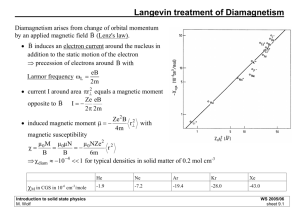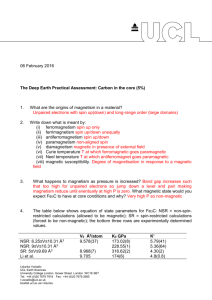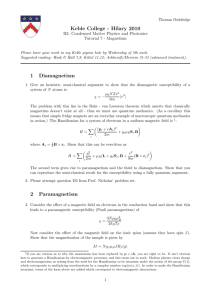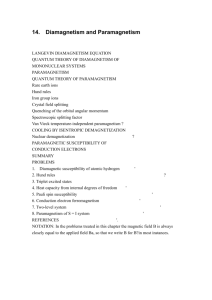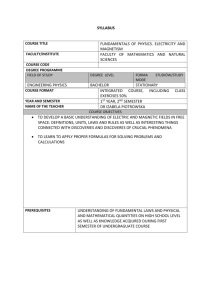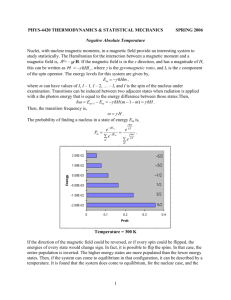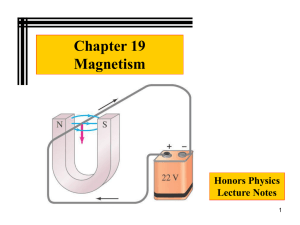Lecture 19
advertisement
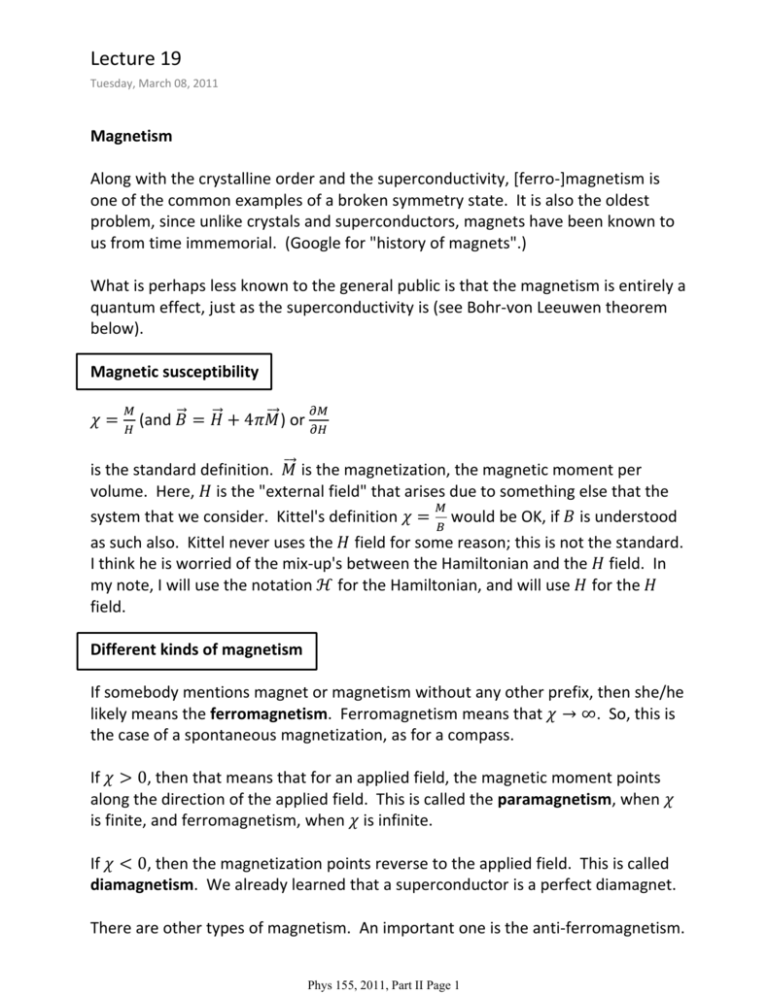
Lecture 19 Tuesday, March 08, 2011 Magnetism Along with the crystalline order and the superconductivity, [ferro-]magnetism is one of the common examples of a broken symmetry state. It is also the oldest problem, since unlike crystals and superconductors, magnets have been known to us from time immemorial. (Google for "history of magnets".) What is perhaps less known to the general public is that the magnetism is entirely a quantum effect, just as the superconductivity is (see Bohr-von Leeuwen theorem below). Magnetic susceptibility (and ) or is the standard definition. is the magnetization, the magnetic moment per volume. Here, is the "external field" that arises due to something else that the system that we consider. Kittel's definition would be OK, if is understood as such also. Kittel never uses the field for some reason; this is not the standard. I think he is worried of the mix-up's between the Hamiltonian and the field. In my note, I will use the notation for the Hamiltonian, and will use for the field. Different kinds of magnetism If somebody mentions magnet or magnetism without any other prefix, then she/he likely means the ferromagnetism. Ferromagnetism means that . So, this is the case of a spontaneous magnetization, as for a compass. If , then that means that for an applied field, the magnetic moment points along the direction of the applied field. This is called the paramagnetism, when is finite, and ferromagnetism, when is infinite. If , then the magnetization points reverse to the applied field. This is called diamagnetism. We already learned that a superconductor is a perfect diamagnet. There are other types of magnetism. An important one is the anti-ferromagnetism. Imagine that per unit cell there is an atom A and an atom B (they are often the Phys 155, 2011, Part II Page 1 Imagine that per unit cell there is an atom A and an atom B (they are often the same kind of atoms just labeled differently). Suppose that atom A's form a ferromagnet and atom B's form another ferromagnet, but their magnetization cancels each other exactly so that the total magnetization is zero. This is the antiferromagnetism. Here is a picture for it. Bohr-von Leeuwen theorem According to this theorem, Classical mechanics cannot explain magnetism. It is very easy to prove it. From Stat-Mech, recall that the partition function for a classical system is given as But, , where without (with) the field, and be simply shifted so that Thus, we just showed that ( ) is the Hamiltonian function . Notice however the integral over can . Since the partition function does not depend on the applied field, and so . Therefore, the system has no magnetic response, and thus no magnetism. Also, the majority of magnetism arises due to the electron spin, which is absent in Classical Mechanics. Origin of magnetic moments The magnetic moment is classically defined as the area time the current of a current loop, divided by c in the cgs unit. For an electron in an orbital motion, we have eigenvalue of as . It is customary to use is just an integer. Then, Phys 155, 2011, Part II Page 2 so that the where is the important Bohr magneton. For the spin angular momentum, where (QED by Dirac, Feynman, ...). Note that for a lab generated field is a very small energy scale. For a fairly strong field of 10 Tesla, meV. In a magnetic material, an internal field that is roughly 1000 times larger can be generated. The source of this extremely large internal field is the Coulomb interaction. Now, suppose that one fills a given shell such as the shell with the maximum number of electrons (2). Then quantum mechanics says that the state has zero angular momentum, spin or orbital. A finite angular momentum, and thus a finite magnetic moment, per atom arises only when there are un-filled shells. Such shells occur in transition metal atoms ( ; Mn, Fe, Cu, ...) and rare earth metal atoms ( ; Ce, Sm, Nd, U, ...). The total quantum numbers for the atom with an un-filled valence shell are often determined by the empirical Hund's rule (Lecture 1). Indeed, any strong magnets or anti-ferromagnets would contain, as a rule, either transition metal atoms or rare earth metal atoms. Origin of magnetism Consider the system of free electrons in a constant field. We take , which leads to We add the spin term , where , to get the full Hamiltonian Phys 155, 2011, Part II Page 3 We add the spin term , where , to get the full Hamiltonian Consider the ground state affected by the field. In order to calculate the susceptibility for atoms and molecules (where the energy levels are discrete and the level spacings are generally much larger than magnetic energy levels), we can use the perturbation theory to calculate the energy up to order . Pretty much every substance has a tendency to become diamagnetic. Why is this? Suppose the ground state has no spin or orbital angular momentum in that . This would be the case for atoms and ions with filled shells. Then, only the third term is non-zero, and it is easy to see that (here we are consider the case only, but consideration of excited states at a finite T does not change this argument). This is the only effect in molecular solids (such as Ar) or ionic insulators, and this diamagnetism is called the Larmor diamagnetism. This is the diamagnetism you would expect from this classical mechanics like reasoning. In the case of an electron with orbital angular momentum vector in an field, it experiences a torque (note that in this discussion, to this torque is the Larmor precession, , not ). One possible motion due since for the precession. Assuming that magnetic moment , we have an induced , which means a term in the Hamiltonian The second term in paramagnetism. with , as above. is a paramagnetic term, and gives rise to the van Vleck The first term in is also a paramagnetic term, and gives rise to the Langevin paramagnetism; this is the term responsible for Curie's law. If present, then this term is dominant over both the Larmor term and the van Vleck term. Phys 155, 2011, Part II Page 4 term is dominant over both the Larmor term and the van Vleck term. The discussion based on is limited to atoms and molecules. How about free electrons in the conduction band or free holes in the valence band? Their magnetism can be described within the degenerate electron gas model that we described in the early part of this course. The three behaviors emerge. Pauli paramagnetism, Landau diamagnetism, and an oscillatory modulation (de Hass van Alphen effect). Pauli paramagnetism is analogous to the Langevin paramagnetism above, in that it arises due to the alignment of the spin magnetic moments of free electrons. Due to the Fermi statistics, however, only the fraction of the total number of electrons contribute to the Pauli paramagnetism. Landau diagmanetism is analogous to the Larmor diamagnetism, and reflects the Lenz law. Except for the Langevin paramagnetism, all of these are typically very small effects, . Langevin paramagnetism is inversely proportional to the temperature (Curie's law), and, at room temperature and below, it is typically stronger by 100 times or more than other effects above. Nowhere here is the discussion of the ferromagnetism or antiferromagnetism, the highlight of magnetic phenomena. Why is this? It is because they cannot be described simply in terms of one electron behavior. They are collective behaviors that rely on an emergence of self-generated field by all electrons that take part in the magnetism. Ferromagnetism can be thought of as a Langevin paramagnetism with a self-generated field, or a Pauli-paramagnetism with a self-generated field. Anti-ferromagnetism is an entirely different story, and requires the discussion of the Hubbard Hamiltonian and the Anderson superexchange. So, the theory tends to be quite involved and advanced, but we will get a taste of them below. Curie's law For collection of local moments, at high temperature or low field, where : number of local moments, Since this is a strong magnetic response, any small amount of magnetic impurities Phys 155, 2011, Part II Page 5 Since this is a strong magnetic response, any small amount of magnetic impurities in a non-magnetic material (like a metal or a semiconductor) easily results in a contamination of the signal. The derivation of the above result is quite standard found in any stat-mech book, or our Kittel book. Pauli susceptibility for a free electron gas This susceptibility is nearly temperature independent, as long as . Note the reduction from the Curie susceptibility by the factor of . For derivation, recall from the actual lecture or Kittel. Landau susceptibility for a free electron gas The Landau diamagnetic susceptibility is given by . The derivation can be found in many magnetism books, or on the web, e.g. http://physics.ucsd.edu/students/courses/winter2010/physics211b/lectures.html The thing about the Landau diamagnetism is that its magnetism depends on the effective mass (determined by the band structure in the case of semiconductors), and thus, in reality, we should have Here, is the free electron mass, and is the effective mass for the orbital motion of the electron. And thus, for semiconductors, the Landau diamagnetism easily wins. In metals, the typical tendency is that , which is another reason why the magnetic response of metals is dominated by the Pauli susceptibility. Cooperative Effect -- Anti-ferromagnetism As mentioned above, the large magnetic effects observed in solids are not just a mere response of a system to an external field, but a cooperative effect -electrons generate their own magnetic field and respond to it. This is the origin of ferromagnetism and anti-ferromagentism. An example of the theory of the ferromagnetism is the Weiss molecular field Phys 155, 2011, Part II Page 6 An example of the theory of the ferromagnetism is the Weiss molecular field theory, which is again very standard and can be found in stat-mech books and Kittel. In this theory, the "mean field" generated by all spins other than the one spin in focus will generate a magnetic field on that one spin, and the problem can be solved self-consistently. Another mechanism of ferromagnetism is the small Hubbard model ("itinerant ferromagnetism" with the "Stoner criterion": Kittel problem 11.6). An example of the theory of anti-ferromagnetism is the Anderson superexchange. Consider a ...-F-Mn-F-Mn-F-… chain for example, as a crude model of the anti-ferromagnet MnF2. Here Mn has a total spin moment of 5, one eigenstate being the 5 electrons all occupying the same spin state. Now, the electron orbitals in F weakly hybridize with the orbitals in Mn to lower the bond energy a little bit. Suppose on one Mn site, all up spins are occupied. Then, it follows that the energy lowering will occur if Mn orbitals of down spins and down spin orbitals of F orbitals hybridize. As a consequence, it is energetically more favorable for the next Mn atom to have all spins pointing down, so that it can then share hybridized orbitals of up spin with the same F, since that F already shared a hybridized orbital of down spins with the other Mn. This is the so-called Anderson super-exchange. Another mechanism is illuminated by considering the so-called "Hubbard model." Consider a 1D hydrogen crystal with one electron per unit cell. Consider the tight binding band with a hopping amplitude , but this time consider the Coulomb energy , the energy cost of putting two electrons in the same hydrogen site. Since is large, it follows that the ground state of this system is, despite the Wilson's theorem, an insulator with one electron each occupying each hydrogen site. Furthermore, it can be seen that the state in which all electrons are occupied ferro-magnetically, each spin pointing in the same direction, is not perturbable, while the state in which neighboring spins are anti-ferromagnetically aligned is perturbable by the hopping amplitude. Considering the 2nd order pertubation, it follows that the energy lowering is and this is the source of in the Heisenberg Hamiltonian, applicable to this system, Phys 155, 2011, Part II Page 7 The Heisenberg Hamiltonian thus derived inherently has a very strong selfgenerated magnetic field acting on each spin. The Anderson super-exchange model is very fundamental in real materials such as MnF2, FeO, high temperature superconductors, etc. However, the model is significantly more complicated than the Hubbard model, and some researchers approximately map the Anderson super-exchange model to a Hubbard model. Phys 155, 2011, Part II Page 8

